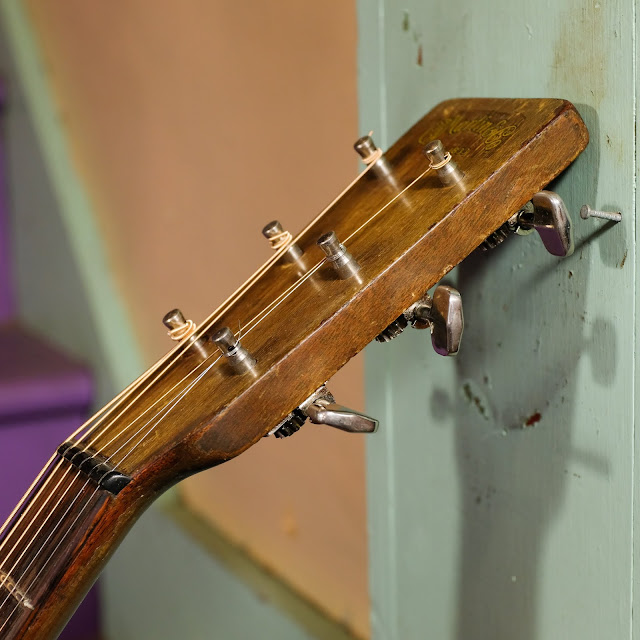1944 Martin 00-17 Flattop Guitar
Older 00-17s and 00-18s are my favorite Martins, generally. This 00-17 has that '40s sweetness and smooth character to its voice that suits chordal back-up so well and it's loud to boot. It's also got that woody chunk that lends it a good flatpicking lead/fill sound, too. These are just plain good, practical, all-arounders.
The earlier ones, like this guy, feature ebony-rod neck reinforcement and a lightweight build. To my ears, they sound a little fuller than '50s and '60s versions, with a more-sweet lower-mids and treble response and a wider low-end. Still, we're talking mahogany-top 00, here, so this is definitely not a dreadnought sort of low-end. It does have scalloped braces, however.
This arrived pretty beat-up and with multiple old, funky crack repairs to the top and back. The original bridge was split and "repaired" to the point of uselessness, the neck angle was terrible, and it just needed some love.
Work included: a neck reset, fret seating and level/dress, install of a new rosewood bridge with a modern, drop-in saddle slot and pins set slightly farther aft, bridge pin hole fill/redrill to go along with it, cleating of the top/back cracks where possible, general cleaning, and a setup. The neck is essentially straight, but does deflect ~1/64" overall tuned to pitch. This is pretty bog-standard for non-adjustable Martin necks. It plays with bang-on 3/32" EA and 1/16" DGBE action at the 12th fret and I have it strung with gauges 54w, 40w, 30w, 22w, 16, 12.
Scale length: 24 13/16"
Nut width: 1 11/16"
String spacing at nut: 1 1/2"
String spacing at saddle: 2 1/4"
Nut width: 1 11/16"
String spacing at nut: 1 1/2"
String spacing at saddle: 2 1/4"
Body length: 18 7/8"
Lower bout width: 14 1/2"
Upper bout width: 10 7/8"
Lower bout width: 14 1/2"
Upper bout width: 10 7/8"
Side depth at endpin: 4"
Top wood: solid mahogany
Back/sides wood: solid mahogany
Neck wood: mahogany
Fretboard: rosewood
Back/sides wood: solid mahogany
Neck wood: mahogany
Fretboard: rosewood
Neck shape: ~14" radius slim-to-medium C/V soft rear profile
Bridge: new Jake-made rosewood
Nut: original ebony
Saddle: new, compensated bone
Condition notes: unoriginal tuners (they're late '50s or early '60s Grovers), lots of wear and tear and weather-check and yellowing to the finish, replacement bridge, saddle, and bridge pins, and various old repairs to top and back cracks (all stable, but not pretty).
My new repro-ish bridge is the same size and shape as the original, but I've relocated the pin holes slightly more aft and used a drop-in saddle slot rather than a through-cut one. I know that's non-original in spec, but considering that this is a player's sort of guitar and that the original bridge designs usually bite the dust on the quick, I figured this was more practical.
It can always be modified to a through-cut slot easily, too -- especially if you enjoy the front wall of your bridge exploding forwards over time!
Here are the cracks on the top-lower-bout -- gloppily-glued and backed with some sort of blue canvas material who-knows-how-long-ago. They're stable, though.
While the Grovers that're on it are replacements, they work well and look good. This would have had the "big-bottom," open-backed Kluson units when it was made.
There are two, 3-4" hairline cracks on the back that're also old repairs. These have a bunch of glue shoved into them so my ability to cleat them was minimal. They're stable, though.
It comes with what appears to be an original case. The handle needs new padding but it's -- surprisingly -- in decent-enough shape for light use.






















Comments
Nice to see such a sympathetic restoration as always